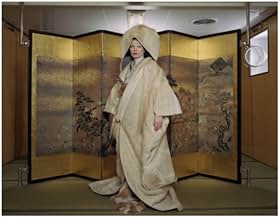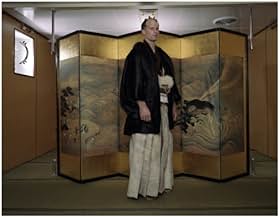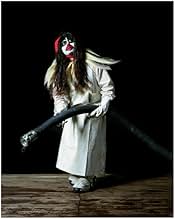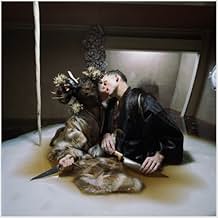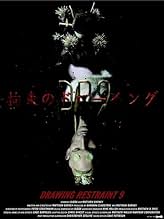AVALIAÇÃO DA IMDb
6,5/10
1,6 mil
SUA AVALIAÇÃO
Adicionar um enredo no seu idiomaThe film concerns the theme of self-imposed limitation and continues Matthew Barney's interest in religious rite, this time focusing on Shinto.The film concerns the theme of self-imposed limitation and continues Matthew Barney's interest in religious rite, this time focusing on Shinto.The film concerns the theme of self-imposed limitation and continues Matthew Barney's interest in religious rite, this time focusing on Shinto.
- Prêmios
- 1 indicação no total
Avaliações em destaque
I just saw this the other day. I Was in the second row of the cinema so close to all these weird happenings. I knew that it would be slow and hardly without a story. With that in mind I really liked the slow moving pictures, the building of the big Vaseline-sculpture, and the meeting between Björk and Barney(it takes a long time before they actually meet on screen)
I see why some people would find it annoying, but to me it had some stunning visuals and the music was really good.
Just sit back and relax and don't expect much more than two hours of slow moving and weird stuff.
I see why some people would find it annoying, but to me it had some stunning visuals and the music was really good.
Just sit back and relax and don't expect much more than two hours of slow moving and weird stuff.
There's no dialogue for a while, and then there's some Japanese dialogue, and all the while, I didn't really know what was going on. I was lost at pretty much all times, but that was to be expected. This had "avant-garde" written all over it, and for being an art piece, I guess it's sporadically interesting. It probably achieves what it sets out to do, but whatever that is feels unclear to me. If you want to dive in, there's probably a lot to chew on, but as to whether it would taste any good, who knows. Probably not. But it's challenging. That's more of an observation rather than something that makes it bad or good. And there's some music here composed by Bjork, though she didn't do all the music it seems. I don't know.
That's my take away. I don't know.
That's my take away. I don't know.
Drawing Restraint 9 (5 stars)
Director Matthew Barney Writer Matthew Barney Stars Matthew Barney, Björk Certificate tbc Running time 135 minutes Country USA / Japan Year 2005
Matthew Barney is a visual artist. Think 'film' as in the sort of media that might attract the attention of the Turner Prize or, its American equivalent (with an international remit), the Hugo Boss award. The most recent Hugo Boss award was won by a Brit, Tacita Dean (who has also been shortlisted for the Turner). Barney won it back in 1996 and has garnered a string of prizes since. So you could say that, in his field, he's comfortably at the top of the heap.
I mention all this because you may come to a review of his film with the question, "But will I like it?" And while that question is still open, it is probably rather better than, "Is it any good?"
Although Barney has his critics, even in the art world, to suggest his stuff is rubbish is maybe a bit like saying Meryl Streep can't act: her finished work may vary in quality but it's the product of someone at the top of their profession. But even if Drawing Restraint 9 is great art of which this reviewer is unqualified to say it is reasonable to wonder whether going to the cinema should entail the attitude of mind that going to see a Tate Modern multi-media application might demand. Surely a film-goer has every right to judge a fill as a movie rather than an art exhibit?
Drawing Restraint 9 demands more or perhaps a rather different type of application to the type of movie commonly at art house cinemas. Yet I recall the delightful shock of seeing Bunuel's Un Chien Andalou that unapologetically surrealist outburst that resulted from his friendship with Salvador Dali. Or Andy Warhol's Screen Tests, that reveal astonishing depth in the personalities instructed not to move or blink for four minutes. More recently Béla Tarr's masterpiece, The Man From London, where the scenery carries a force as powerful as the plot or characters. These people dared to use moving pictures in a different way, and cinema is (in my opinion) better for them.
Matthew Barney has little or no interest that I can deduce in conventional cinematic form. When it comes to film, it is as if he started with a blank page, or another medium upon which to bend like sculpture and ideas. Fans of his earlier Cremaster cycle of films will recognise a certain organic development in his films: the plots and persons seems to grow in a way that mimics the growth of crystals, or of speeded up plant growth, all redolent with arcane or sexual symbolism.
Drawing Restraint 9 seems to me a more rounded and mature work than his Cremaster opus. It is more tightly structured and coherent. The viewer can piece together the threads of stories by patient observation. The work of a Japanese whaling ship and various issues surrounding its trade, and the Shinto marriage ceremony on board. During an intense lightning storm the tea ceremony / marriage ceremony takes on disturbing dimensions that set our mind and senses racing.
Barney's (real life) partner, Bjȍrk also combines many new ideas in creating the music. The main suite is written for the sho, one of Japan's most ancient instruments. She worked with Noh theatre scholars to develop musical settings for a poem to produce an authentic, haunting sound.
Drawing Restraint 9 is no more an easy cinematic experience than a Rodin is a catchy picture postcard. But it rewards serious attention and its lyrical and elegiac qualities make the journey an interesting one. The strange visual experiences will leave an impression even on viewers that don't delve beyond the surface. Those that do, will find Barney has drawn his cinematic sculpture on sound ideas and symbols of substance.
Director Matthew Barney Writer Matthew Barney Stars Matthew Barney, Björk Certificate tbc Running time 135 minutes Country USA / Japan Year 2005
Matthew Barney is a visual artist. Think 'film' as in the sort of media that might attract the attention of the Turner Prize or, its American equivalent (with an international remit), the Hugo Boss award. The most recent Hugo Boss award was won by a Brit, Tacita Dean (who has also been shortlisted for the Turner). Barney won it back in 1996 and has garnered a string of prizes since. So you could say that, in his field, he's comfortably at the top of the heap.
I mention all this because you may come to a review of his film with the question, "But will I like it?" And while that question is still open, it is probably rather better than, "Is it any good?"
Although Barney has his critics, even in the art world, to suggest his stuff is rubbish is maybe a bit like saying Meryl Streep can't act: her finished work may vary in quality but it's the product of someone at the top of their profession. But even if Drawing Restraint 9 is great art of which this reviewer is unqualified to say it is reasonable to wonder whether going to the cinema should entail the attitude of mind that going to see a Tate Modern multi-media application might demand. Surely a film-goer has every right to judge a fill as a movie rather than an art exhibit?
Drawing Restraint 9 demands more or perhaps a rather different type of application to the type of movie commonly at art house cinemas. Yet I recall the delightful shock of seeing Bunuel's Un Chien Andalou that unapologetically surrealist outburst that resulted from his friendship with Salvador Dali. Or Andy Warhol's Screen Tests, that reveal astonishing depth in the personalities instructed not to move or blink for four minutes. More recently Béla Tarr's masterpiece, The Man From London, where the scenery carries a force as powerful as the plot or characters. These people dared to use moving pictures in a different way, and cinema is (in my opinion) better for them.
Matthew Barney has little or no interest that I can deduce in conventional cinematic form. When it comes to film, it is as if he started with a blank page, or another medium upon which to bend like sculpture and ideas. Fans of his earlier Cremaster cycle of films will recognise a certain organic development in his films: the plots and persons seems to grow in a way that mimics the growth of crystals, or of speeded up plant growth, all redolent with arcane or sexual symbolism.
Drawing Restraint 9 seems to me a more rounded and mature work than his Cremaster opus. It is more tightly structured and coherent. The viewer can piece together the threads of stories by patient observation. The work of a Japanese whaling ship and various issues surrounding its trade, and the Shinto marriage ceremony on board. During an intense lightning storm the tea ceremony / marriage ceremony takes on disturbing dimensions that set our mind and senses racing.
Barney's (real life) partner, Bjȍrk also combines many new ideas in creating the music. The main suite is written for the sho, one of Japan's most ancient instruments. She worked with Noh theatre scholars to develop musical settings for a poem to produce an authentic, haunting sound.
Drawing Restraint 9 is no more an easy cinematic experience than a Rodin is a catchy picture postcard. But it rewards serious attention and its lyrical and elegiac qualities make the journey an interesting one. The strange visual experiences will leave an impression even on viewers that don't delve beyond the surface. Those that do, will find Barney has drawn his cinematic sculpture on sound ideas and symbols of substance.
As with reading all comments, you will find it useful to know where the writer is placed. I have watched the first "Cremaster" and Barney's entry in the "Destricted" compilation. That latter piece was a failure in my mind. There's not much overlap between the sculptural and the cinematic anyway. One is more on the noun side, the other on the verb side: contextual, environmental. I admire that he tried to find that commonality in the erotic, but the result is rather sophomoric in all but the initial choices.
This isn't wonderful either. I hold hope for the later "Cremaster" experiences, that there will be some valuable conversation between us. This is a wholly different thing altogether. This man has found his love, and has created a valentine. Its a conversation, an intercourse between the two of them. The value we are expected to get is in witnessing rather than participating.
The forms he has chosen are all Japanese because they have developed an observational distance with the ordinary things of their life we do not have.
The basic urge here is the melding of the two lives: Bjarney, but with careful, artificial constraints. We have the merging of the tea ceremony with the whaling ritual; the reversal of rendering blubber to whaleoil to the coagulation of pseudoblubber from pseudowhaleoil.
We have the melding of humans with whales, ambergris with pearls, constructing whale icons with consumption...
And of course the conflating of Barney's sculptural objects with Japanese ritualistic ones. I am not well enough versed in details of Japanese esoterica to know where one starts and the other stops, but I suppose in his view it is perfectly balanced, one "restraining" the other; one "drawing" the other, each drawing restraints on another level: tea to whale and so on.
The most engaging sequence is at the beginning: three phenomenal episodes: one the wrapping of two packages, bodies; a second the procession of the whale oil returned and ritual construction thereupon; and finally a dive into the water seeking marine truth, revealing a hot blade (seen later as the humans transform into whales).
Its not for us, they made this. Its a conversation of love and commitment between the two. We've only crew members.
Ted's Evaluation -- 3 of 3: Worth watching.
This isn't wonderful either. I hold hope for the later "Cremaster" experiences, that there will be some valuable conversation between us. This is a wholly different thing altogether. This man has found his love, and has created a valentine. Its a conversation, an intercourse between the two of them. The value we are expected to get is in witnessing rather than participating.
The forms he has chosen are all Japanese because they have developed an observational distance with the ordinary things of their life we do not have.
The basic urge here is the melding of the two lives: Bjarney, but with careful, artificial constraints. We have the merging of the tea ceremony with the whaling ritual; the reversal of rendering blubber to whaleoil to the coagulation of pseudoblubber from pseudowhaleoil.
We have the melding of humans with whales, ambergris with pearls, constructing whale icons with consumption...
And of course the conflating of Barney's sculptural objects with Japanese ritualistic ones. I am not well enough versed in details of Japanese esoterica to know where one starts and the other stops, but I suppose in his view it is perfectly balanced, one "restraining" the other; one "drawing" the other, each drawing restraints on another level: tea to whale and so on.
The most engaging sequence is at the beginning: three phenomenal episodes: one the wrapping of two packages, bodies; a second the procession of the whale oil returned and ritual construction thereupon; and finally a dive into the water seeking marine truth, revealing a hot blade (seen later as the humans transform into whales).
Its not for us, they made this. Its a conversation of love and commitment between the two. We've only crew members.
Ted's Evaluation -- 3 of 3: Worth watching.
DR9 shouldn't really be thought of as a film in the traditional sense of the word, nor should it sit alone, its part of a greater work of art, the clue is in the title! To really appreciate the film it helps to see it in relation to sculpture and the way objects interact within a chosen space. also the resonance of ritual and especially Japanese shinto can bring a certain amount of meaning and clarity to some of the more obscure sequences in the film. even though it seems very 'serious and arty' on the surface ,there is humour and romance and the film! try not to see it as a finite static thing, but something that can change according to the multiple layers you allow yourself to perceive it on.
Você sabia?
- Trilhas sonorasGratitude
Written by Björk and Matthew Barney
Vocal by Will Oldham
Harp played by Zeena Parkins
Celeste played by Jónas Sen
Keyboard played by Nico Muhly
Arranging & editing by Björk
Programming by Björk and Valgeir Sigurðsson
Produced by Björk
Principais escolhas
Faça login para avaliar e ver a lista de recomendações personalizadas
- How long is Drawing Restraint 9?Fornecido pela Alexa
Detalhes
- Data de lançamento
- Países de origem
- Central de atendimento oficial
- Idiomas
- Também conhecido como
- Растворение мира
- Locações de filme
- Empresa de produção
- Consulte mais créditos da empresa na IMDbPro
Bilheteria
- Faturamento bruto nos EUA e Canadá
- US$ 234.743
- Fim de semana de estreia nos EUA e Canadá
- US$ 18.011
- 2 de abr. de 2006
- Faturamento bruto mundial
- US$ 267.275
- Tempo de duração2 horas 15 minutos
- Cor
- Mixagem de som
- Proporção
- 1.85 : 1
Contribua para esta página
Sugerir uma alteração ou adicionar conteúdo ausente

Principal brecha
By what name was Drawing Restraint 9 (2005) officially released in Canada in English?
Responda

